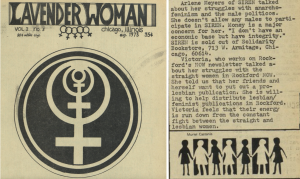Lavender Woman, a lesbian periodical that published 26 issues from 1971 to 1976, created space for queer women in a straight, male-dominated society. It’s existence itself was a rebellion against the overpowering voices at the time. The magazine, which took the lavender aspect of its name from the Lavender Menace movement, was written by a collective of women (2). On the first page, there is a list of contributing authors, but no great significance seems to be placed on individual names and there are no page numbers associated with them. Lavender Woman strived to create unity, a value which was enhanced by the collective since each contributor was given similar or equal power within the periodical and much of the credit was shared. The periodicalLavender Woman was comprised of articles, artwork (largely block prints and drawings), and poems targeted at lesbian issues. The major themes of the works centered around helping lesbians feel seen through sharing common experiences of discrimination, love, and navigating sexuality. Lavender Woman aimed to destigmatize lesbians and lesbian relationships while creating a safe space for lesbians to see aspects of their lives reflected in media. The Lavender Woman collective approached this goal by publishing relatable experiences–even painful ones. In one poetry submission from the 1973 vol.2 no.3 edition of Lavender Woman, there was a direct reference to the color lavender being associated with queerness and the fear that goes along with potentially being judged upon further discovery of identity:
SYNTHIA
I want to think of Synthia as clean
Like earth and kind.
But she has bound her hair
With purple and wears stockings
Purple, too. If she were nude?
Or tousled? No.
Somewhere
The purple would show through.
-M. Champaign
“SYNTHIA” focuses on the prejudice against queerness or evidence of “lavender” within a person, which is described as unclean in the poem. Many of Lavender Woman’s readers would have been able to relate to “SYNTHIA” and may have encountered similar interactions. Sharing experiences of discrimination created a further sense of unity because it helped lesbians feel less alone in their experiences.

Cover of the 1973 issue of Lavender Woman, Vol. 2. No. 5 (left), and an excerpt from the Publications Workshop (right).
The female writers in the collective for Lavender Woman were not naïve to the fact that prejudice often follows demonstrations of pride, so they created community by starting many of their articles and headers addressing their queer audience–which they refered to as their sisters. It is not a guarantee that families accept or understand their queer family members, so Lavender Woman called their readers their sisters to create a space for lesbians to feel safe expressing themselves and their love. One untitled poem submission by Sara Thompson addresses young or newly realized lesbians by saying:
We will tell you the truth so that you will understand
The confusion
We will tell you the truth so that you will understand
The pains when they come
We will tell you the truth so that you will see
The joy of being a woman
You must keep your eyes open little sister, all the time
(Thompson, 9)
The authors of Lavender Woman knew the struggles of forsaking the advantages of fitting into male-centered systems, which Cheryl Clark considered in her essay “Lesbianism: An Act of Resistance,” published in This Bridge Called My Back. Clark categorized lesbian sexuality as a form of rebellion due to the many opportunities that came along with proximity to men: the benefit of marriage due to fitting the mold of a “proper woman,” and the stability and income men brought due to sexist societal systems (1). In her essay, Clark viewed lesbians as unified against the patriarchal system–which she called the “slave master”:
“For a woman to be lesbian in a male-supremacist, capitalistic, misoginystic, racist, homophobic, imperealist culture, such as that of North America, is an act of resistance. (A resistance that should be championed throughout the world by all the forces struggling for liberation from the same slave master.)” (Clark, 126)
Although there were marches and protests during the Second Wave Feminist Movement–like the Lavender Menace revolution–Cheryl Clark’s “Lesbianism: An Act of Resistance” argues that just openly existing within a prejudiced society is a rebellion in and of itself.
Work Cited
(1) Moraga, Cherríe, and Gloria Anzaldúa. This Bridge Called My Back: Writings by Radical Women of Color. SUNY Press, 2021. pp. 126.
(2) Kate Kasten, et al. Lavender Woman. Lavender Woman, vol. 2, no. 5, Lavender Woman, Aug. 1973, pp. 1–21, https://jstor.org/stable/community.28039112.
